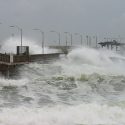State climatologist: Drought continues in Madison area
Near-normal rains in October did little to alleviate the long-term drought that has gripped the Badger state since the spring, says State Climatologist John Young.

Young
South-central Wisconsin, the region that encompasses Dane County, gets 35 inches of rain in the average year, but received just 23 inches in the 12 months that ended Oct. 31.
“Especially when this shortage occurs in the summer, it hurts,” says Young, an emeritus professor of atmospheric science at the University of Wisconsin–Madison. “I am not sure I have seen a drought this intense, this long-lasting, in 45 years of watching Wisconsin’s weather.”
March, Young notes, was “more like June, 15 degrees above average.”
Heat exacerbates drought by speeding evaporation, which dries the soil and stunts plants, and nine of the last 12 months have been significantly warmer than the 1980-2010 average.
“If you are talking about a drought that influences living things, plants, animals, and the availability of water, it’s hot temperatures as well as low precipitation that will hurt,” Young says.
The rains more or less stopped in April, and did not resume until October, Young observes. “In south-central Wisconsin, it was dry for six months in a row. June just killed us, as there was hardly had a drop. That was more than four inches below normal.”
Statewide, the drought cut the corn yield an estimated 20 percent.
Several large atmospheric conditions contributed to the heat and drought, Young says. “In March, this monster hot-air mass from Mexico inhabited a huge part of North America, something we have hardly ever seen before,” he says.
Since then, the Great Plains from Texas to the Dakotas has been in the grip of an “exceptional” drought with overtones of the Dust Bowl during the 1930s.
“This kind of pattern has been around for several months,” says Young. “It’s too dry, sickening for some, and we in Wisconsin are on the eastern fringe of a lingering national drought.”
Long-term weather patterns like these can be affected by El Nino, a warm-water pool in the Pacific Ocean that alters the path of jet streams and storms. El Nino predictions have some success months in advance. But while droughts and heat waves are consistent with expectations for global warming, it’s never possible to attribute any particular weather event to warming, Young says.
Rather, a warming climate raises the odds of abnormally warm days — including our recent “summer in March” — and disruptions such as drought or even extreme rainfall.
“This is the kind of weather we expect as the climate warms, and both precipitation extremes have affected us the past few summers,” Young adds.
Although the crops are harvested and headlines about drought have faded, “Eighty-seven percent of the state is in some level of long-term drought, and that’s important for groundwater, lakes and large trees,” Young says. “The long-term indicators are actually more ominous than they were a few months ago because drought takes months to develop, and months to recover.”
The long-term drought index measures water deep in the soil, which continues to be scarce after an unrelentingly hot, dry year, Young adds. “Starting last November, and running through September, in south-central Wisconsin, the temperature was way above normal every month except for April.”
Meanwhile, rainfall in this region was significantly short between April and September. If the drought continues into next summer, farmers are likely to notice further yield declines, Young adds.
An occasional thunderstorm, no matter how wet, makes little difference to the overall picture, Young says. “The drought indices measure average rain over weeks and months. You do not lift a drought by one day of heavy showers; the drought wasn’t formed in a day, and it won’t end in a day.”
For more data from the state climatologist’s office, visit here.
Tags: climate change, research



